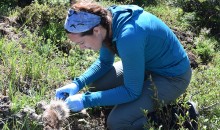Ben Williamson
Near the end of May, a caribou died on a mountainside. We know this because it happened to be wearing a radio-collar for research. If the collar doesn’t move for eight hours, it sends out a mortality signal and we make arrangements to investigate the site, ideally within 24 hours.

This time the Caribou Program‘s efforts were frustrated for three weeks as weather and circumstance prevented a safe helicopter flight deep into the wilderness. Finally, on June 20, Laura Finnegan and Doug MacNearney were able to reach the mortality site.
The death scene investigations are for a project that is uncovering the causes of caribou mortality in west-central Alberta herds. The goal is to retrieve the collar and determine the cause of death, as well as to collect samples of scat, hair, bones, and other tissues to detect any underlying health problems. For example, a caribou might be killed by wolves, but an underlying problem such as poor nutrition or disease might have made that caribou more vulnerable to predation than a healthy animal.

This particular caribou was part of the Redrock-Prairie Creek herd. We found signs that it was taken down by a grizzly bear. At other mortalities, we’ve seen signs of predation by cougars, bears, wolves, and sometimes more than one species of predator. The hope is that by better understanding the threats to caribou, managers can make better-informed decisions that will allow caribou to recover over the long run.








